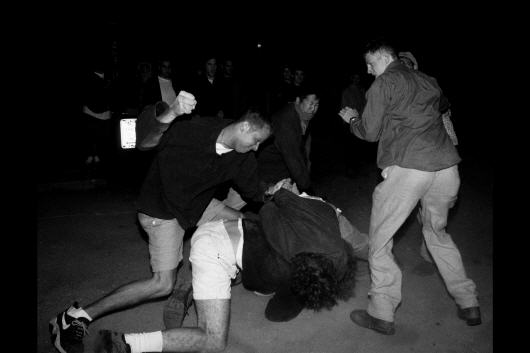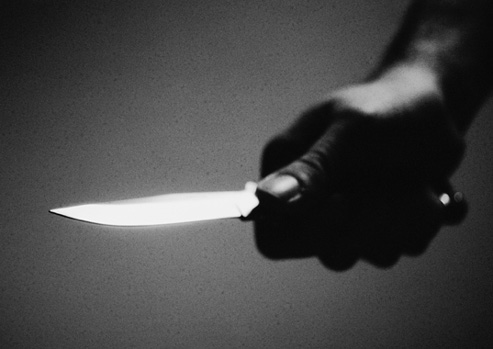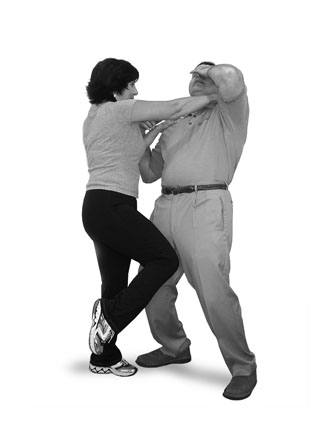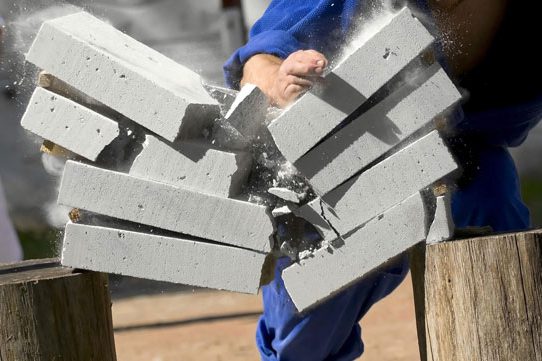“I swear, that was the last time, man! I’m starting boxing tomorrow!”
My friend was pretty upset, and quite rightfully so. Last night he had been attacked, robbed and beaten up for the fourth or fifth time this year, and nobody of us could understand why. “He is so kind to everybody! Why would anybody want to harm him?” me and my friends kept saying to each other.
So, my bruised friend began boxing.
And of course it didn’t help him a bit.
I tried telling him several times that boxing is a sport, and if he wants to learn effective self-defense there are better ways! Like training Karate! Or being aware of your surroundings, to begin with. But he wasn’t listening. “Like your Karate-dances are going to save your ass when a bunch of hooligans jump you!?”
Boxing made him feel strong and self-confident. He could already bench press twice his bodyweight, so he probably figured that he would become the ultimate killing machine, once he had mastered boxing.
And hopefully nobody would ever try to hurt him again.
How wrong he was.
When I met him a couple of months later, his right hand looked like that of an old Egyptian mummy. It had been broken, when he finally tried fighting back for once. “I told you boxing is a sport!” I said to him, but he didn’t care. He told me how he had been out jogging, around 11 PM the other night, when he was approached by three young men.
“What’s up?” the leader had asked him.
“Sorry guys, I’d love to talk, but I’ve got to jog. See you!” he had told them, sensing that they were looking for trouble.
He turned around and ran, hoping that they wouldn’t follow. But soon enough they were running next to him. One on his left side, one on his right side, and one behind him.
“We just want to talk!” one of them shouted, with a big grin on his face.
So, my friend decided to see what his boxing had taught him.
He stopped, turned around, and with all his power punched the leader in the head so he fell back (“I never knew a head could be that hard!”), but immediately he was thrown to the ground by the two guys on his sides.
(His boxing coach always said “You’ve got to take some to give some!”.)
The two thugs pinned his arms to the ground with their knees, while the leader (who was recovering from being punched in the head) jumped on top of him. Something quickly flashed before my friends eyes.
A blade.
Luckily, these bad guys were stereotypical – in the sense that the ones who show a knife rarely use it, and the ones who use a knife rarely show it.
They only showed it.
And it was over.
My friend was left lying on the jogging track, alone in the darkness, with a broken hand and a contorted face. Keys, wallet, digital watch and mobile phone taken away.
Naturally, I felt bad for him.
And I told him that he should consider himself lucky that his face wasn’t sliced up.
The thing is, my friend really thought boxing was his knight in shining armour, his saviour. But it had done nothing for him. Except brake his hand. And piss off a knife wielding assailant.
Needless to say, he spent the next three weeks going back to the “crime scene”, searching for his assailants.
He never saw them again.
Now, leaving this story as a backdrop, let me quickly change subject.
Answer this:
“What is beautiful, elegant yet dynamic on the outside, but logical, simplistic and brutal on the inside?”
Did you answer “kata”?
I sure hope so.
Because if you say “kata”, you’re not only very correct, but you obviously know a thing or two about Karate that has gone largely unnoticed by an entire generation of Karate enthusiasts around the world.
Sadly, this knowledge (of the original defensive applications and principles which we are supposed to train and understand), were lost and obscured in the wake of the modernization of Karate.
Frankly, my boxer friend knows more about “the street” than most Karate instructors of today.

Yet, he has never trained for “the street”.
It is my firm belief that Karate’s obvious value as a brutal discipline of percussive impact (aided by joint locks, takedowns, strangulations, throws etc), is something most people claim to practise, but fail to comprehend even at the most basic level.
And I want to see change.
I just don’t know how.
Keep in mind that most Karate people who call themselves “martial artists” are nothing of the sort. Most dojo are not martial arts dojo either (and yes, plural of “dojo” is “dojo”). They are glorified social clubs thriving in an enjoyable environment of emotional stimulation which is further heightened by a false and/or extremely limited perception of danger and reality.
Which is great.
If that’s what you asked for.
“But Jesse-san, what’s the problem? Can’t we just have fun? Why are you being so serious?”
Well, let me ask you this:
If you were to walk into a gun shop, and ask for their best revolver, you would expect to get what you ask for, right? Of course. But what if – when your life might suddenly be in danger – the time comes to actually use that revolver?
What if, at that very moment, you find out that your revolver is a water pistol?
A squirt gun.
You thought you were buying one thing, but you got something completely else.
You thought you were safe because you had the revolver, which may have changed your perception of what constitutes a threat, or perhaps even clouded your judgement.
Here’s a list of attacks.
Please have a look:
Top 10 Street Attacks:
- Push to the chest, often followed by the pushed party throwing a punch at the pushers head.
- Roundhouse or “haymaker” punch to the head.
- Lapel or shoulder grab, one handed, in conjunction with a straight punch to the head.
- Two handed clothing grab, followed by a head butt (“The Glasgow Kiss”).
- Two handed clothing grab, followed by a knee to the groin.
- Bottle, glass, or ashtray to the head.
- Frontward kick to groin/lower legs.
- Broken bottle or other sharp object jabbed to face.
- Slash with a short (3-4 inch) knife.
- Side head lock.
These attacks are the ten most common street attacks, according to British police.
Look at them carefully.
When I saw this list for the first time, I immediately asked one of our black belts in the dojo what he would do if I grabbed his lapel and kneed him in the groin. This is the fifth most common attack in the list above (“5. Two handed clothing grab, followed by a knee to the groin.”).
After ten to twenty seconds of thinking, he gave me an answer.
I didn’t listen. I just said “No. That wouldn’t work”.
So he gave me another, alternative, defense but I said “No, that wouldn’t work either”.
He continued, and gave me some more explanations, but I said “Look, you were kneed in the groin two minutes ago. Nothing you say will work, because the bastard is already jumping on your head!”
If you have to think that hard, something is lacking in your training.
(Hick’s Law, anyone?)
I’m just saying.
It seems that in Karate, theory often supersedes practise. Especially when something is not well understood and/or dangerous.
Why is this happening?
It happens because most Karate instructors of today have no idea (let me repeat that: NO IDEA) how to effectively use the defensive principles contained within kata. Some know, but most don’t. And if they do know, they most likely haven’t practised it enough to be able to spontaneously use it anyway. It doesn’t matter if the sensei is from Okinawa, America or Bombay; has a 10th dan, 5th dan or brown belt.
What’s even more naive is most of them either don’t care about this, or simply think it’s a waste of time!
(They sometimes even tell their students that it’s up to them to figure it out!)
The key is, and has always been, right in front of us.
But for some reason, trying to practically learn, or even theoretically understand, the “dispassionate outcome of self-defense” (effectively impeding motor performance) through analyzing the knowledge presented in simple physical templates (kata) which we know is the original purpose of Karate, is left to weirdos with blogs.
Cowabunga…
But I refuse to believe that I’m the only one who cares about the poor frustrated souls who, believing they get the “real deal”, are presented with learning preposterous applications against equally ridiculous attack scenarios because their style/master says, “it’s the true way”.
Style is just an interpretation of truth.
Truth does not conform to it.
What I’m saying is, though most styles/organizations/masters aren’t wrong, they just promote and preserve something which I can’t stand behind. Something that surprisingly often makes me hesitant of telling people that “Yes, I practise Karate!”.
Because I know what they’ll be thinking.
“If you want to truly understand something, try to change it”.
~ Kurt Lewin
I guess I’m just trying to understand.
How about you?



49 Comments